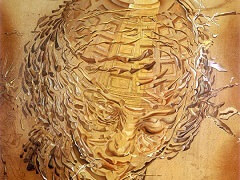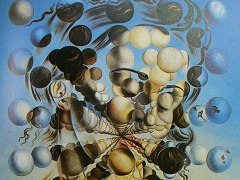Invisible Sleeping Woman, Horse, Lion, 1930 by Salvador Dali

This analytical work is one of the first painted in the new house in Port Lligat during the summer of 1930. In his numerous written works Dali has given us much information about this picture. He wrote:
A month after my return from Paris, I signed a contract with George Keller and Pierre Colle. Shortly after in the tatter's gallery I exhibited my Invisible Sleeping Woman, Horse, Lion, fruit of my contemplation at Cape Creus."
The Viscount of Noailles bought this oil. Invisible Sleeping Woman, Horse, Lion must be considered the most important painting after The Invisible Man among Dali's early experiments with double images. The permanent theme which predominates over all the others is that of the persistence of desires.
Speaking of this picture, Dali has given a definition:
The double image (the example of which may be that of the image of the horse alone which is at the same time the image of a woman) can be prolonged, continuing the paranoiac process, the existence of another obsessive idea being then sufficient to make a third image appear (the image of a lion, for example) and so forth, until the concurrence of a number of images, limited only by the degree of the capacity for paranoiac thought."
The violently erotic character of the group of fellates metamorphosed into the forelegs and the head of the horse is veiled by the immutable aspect of the ensemble, obtained with the help of an absence of dense shadows and violent colors, as well as by the geological character of the forms. Dali said of these models: "They are always boats which seem to be drawn by exhausted fishermen, by fossil fishermen."
Salvador Dali painted three pictures of the same subject with different titles. One of the three was destroyed during the demonstrations which broke out when the film L'Age d'or was being shown at Studio 28 in Paris on December 3,1930.























